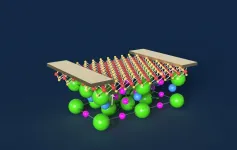(Press-News.org) What if a critical piece of the puzzle of brain aging has been hiding in plain sight? While neuroscience has long focused on proteins and DNA, a team of Stanford researchers dared to shift their gaze to sugars – specifically the complex sugar chains that cover all our cells like chain mail.
Their investigation revealed how changes in this sugary armor on the brain’s frontline cells could be key to understanding cognitive decline and diseases like Alzheimer’s.
“This is like landing on a new planet,” says Nobel laureate Carolyn Bertozzi, professor of chemistry and Baker Family Director of Sarafan ChEM-H, whose groundbreaking research on cell surface sugars and their biological roles laid the groundwork for this interdisciplinary study. “We’re stepping outside for the first time and trying to make sense of what’s out there.”
At the center of this discovery is Sophia Shi, a Stanford Bio-X Graduate Fellow, whose doctoral research bridges the labs of Bertozzi and neuroscientist Tony Wyss-Coray, professor of neurology and neurological sciences and the Director of the Phil and Penny Knight Initiative for Brain Resilience at the Wu Tsai Neurosciences Institute.
In a study in aging mice, Shi has uncovered striking age-related changes in the sugary coating – called the glycocalyx – on cells that form the blood-brain barrier, a structure that protects the brain by filtering out harmful substances while allowing in essential nutrients.
“The glycocalyx is like a forest,” Shi explains. “In young, healthy brains, this forest is lush and thriving. But in older brains, it becomes sparse, patchy, and degraded.”
These age-related changes to the glycocalyx weaken the blood-brain barrier, Shi found. As the barrier becomes leaky with age, harmful molecules can infiltrate the brain, potentially fueling inflammation, cognitive decline, and neurodegenerative diseases.
“This work lays the foundation for a new field of inquiry into how the aging brain loses its resilience,” says Wyss-Coray, the D.H. Chen Professor II of Neurology.
The study, published online in Nature on Feb. 26, was jointly supervised by Bertozzi and Wyss-Coray, with Shi as lead author.
Decline and resilience in the blood-brain barrier
While Wyss-Coray’s lab has extensively studied how aging impacts the blood-brain barrier, Shi’s project was the first to investigate how age affects its sugary armor – the glycocalyx. The results were striking: In older mice, bottlebrush-shaped, sugar-coated proteins called mucins, a key component of the glycocalyx, were significantly reduced. This thinning of the glycocalyx correlated with increased permeability of the blood-brain barrier and heightened neuroinflammation.
When the team reintroduced those critical mucins in aged mice, restoring a more “youthful” glycocalyx, they improved the integrity of the blood-brain barrier, reduced neuroinflammation, and measurably improved cognitive function.
“Modulating glycans has a major effect on the brain – both negatively in aging, when these sugars are lost, and positively, when they are restored,” Shi says. “This opens an entirely new avenue for treating brain aging and related diseases.”
Bertozzi underscores the significance of the discovery: “Biology is often about looking in the right place. This huge structural change in the glycocalyx was hiding in plain sight because no one had thought to look at it before, or had the tools to do so.”
Shi’s work also raises new questions. While the glycocalyx is traditionally viewed as a passive barrier that blocks harmful substances from entering cells, its sugars may play a more active role in the brain and how it ages.
Scientists often look to nucleic acids and proteins to understand how biological processes are precisely controlled, but they may be missing the roles that sugar molecules play, Bertozzi explains. “The glycome adds a layer of complexity that allows biological systems to achieve extraordinary fine-tuning.” This is particularly true in the brain, where many sugar molecules are uniquely expressed. Yet, until now, their roles in brain aging and disease have remained largely unexplored, she adds.
Shi’s dual expertise in chemistry and biology enabled her to tackle a problem that neither lab could have solved alone. This study also brought together the two interdisciplinary institutes that share the Stanford ChEM-H / Neurosciences Research Complex: Sarafan ChEM-H and the Knight Initiative for Brain Resilience at the Wu Tsai Neurosciences Institute.
The brain’s sugar shield and disease
Many questions remain about the glycocalyx – what drives its decline with age, and do similar changes occur in humans? “It’s hard to study human brains,” Bertozzi notes, “but understanding whether similar mechanisms are at play in humans will be crucial for translating these discoveries into therapies.”
The study also offers new opportunities to tackle neurodegenerative diseases like Alzheimer’s, a particular interest for Shi. By identifying the molecular pathways behind glycocalyx changes, the team hopes to uncover therapeutic targets that could slow or even reverse disease progression. Shi, who will soon establish her own lab at the Rowland Institute at Harvard, plans to expand this research to better understand glycans’ roles in neurodegeneration and explore their potential for developing new treatments.
Beyond aging and neurodegeneration, the findings have significant implications for effectively delivering drugs to the brain. The blood-brain barrier is notoriously difficult to penetrate, making it challenging to treat many neurological diseases. By understanding the role of the glycocalyx, scientists may discover better ways to get medicines into the brain, offering hope for conditions ranging from multiple sclerosis to brain cancer.
For now, this work represents a first step into a new field. As Shi puts it, “I’m excited to unlock the secrets of the glycocalyx in brain aging and neurodegeneration and discover how we can harness its potential to improve brain health.”
For more information
Stanford’s Office of Technology Licensing has filed for a patent on intellectual property associated with this study.
Sophia Shi, the study’s lead author, is a Stanford Bio-X Graduate Fellow and PhD student in the Department of Chemistry. She is co-supervised by Carolyn Bertozzi, PhD, and Tony Wyss-Coray, PhD. Bertozzi is Baker Family Director of Sarafan ChEM-H, Anne T. and Robert M. Bass Professor in the School of Humanities and Sciences and a professor of chemistry, while Wyss-Coray is the D.H. Chen Professor II of neurology and Director of the Phil and Penny Knight Initiative for Brain Resilience. Both are faculty affiliates of the Wu Tsai Neurosciences Institute.
Other Stanford co-authors of the study are Ryan J. Suh, D. Judy Shon, Josephine K. Buff, Micaiah Atkins, Nannan Lu and M. Windy McNerney. Researchers at the Picower Institute for Learning and Memory, Palo Alto Veterans Institute for Research, Hong Kong Center for Neurodegenerative Diseases and The Hong Kong University of Science and Technology also contributed to this work.
This research was funded by the Department of Veterans Affairs, the National Institutes of Health, the Phil and Penny Knight Initiative for Brain Resilience, the Bev Hartig Huntington’s Disease Foundation, and the JPB Foundation.
END
Aging and the brain’s sugar-coated shield
2025-02-27
ELSE PRESS RELEASES FROM THIS DATE:
Better poverty mapping: New machine-learning approach targets aid more effectively
2025-02-27
ITHACA, N.Y. – Leveraging national surveys, big data, and machine learning, Cornell University researchers have developed a new approach to mapping poverty that could help policymakers and NGOs better identify the neediest populations in poor countries and allocate resources more effectively.
To eliminate extreme poverty, defined as surviving on less than $2.15 per person per day, governments and development and humanitarian agencies need to know how many people live under that threshold, and where. Yet that information ...
An emissions tale of two cities: Salt Lake City vs. Los Angeles
2025-02-27
They may both be Olympic host cities, but Salt Lake City and Los Angeles, the major population hubs of their respective states, are much different places. However, they both experience poor air quality and share valley topography that traps pollutants during weather inversions.
Utah and Southern California differ sharply in their approaches to this problem, with the latter implementing more stringent regulations and fuel standards aimed at reducing emissions from motor vehicles. New research from the University ...
WVU nursing faculty aim to enhance rural home care for chronically ill through NIH award
2025-02-27
Three West Virginia University nursing faculty know firsthand the difficulties faced by family caregivers and their chronically ill loved ones.
With a $2.7 million award from the National Institutes of Health’s National Institute of Nursing Research that is one of the largest ever for the WVU School of Nursing, the faculty researchers aim to support these families while increasing access to care in the rural reaches of the Mountain State by testing an integrated, nurse-led intervention for family home care management of end-stage heart failure and palliative care.
“We want to know if there’s a way we can help relieve the suffering for these individuals ...
New screening tool for stroke survivors with visual perception problems
2025-02-27
A new 15-minute tool to screen stroke survivors for visual perception problems has been launched by researchers from Durham and Oxford universities.
The free screening tool could make it easier for health professionals to identify difficulties in patients after a stroke and meet the need for an assessment that is quick and simple to administer.
The research behind the screening tool, funded by the National Institute for Health and Care Research (NIHR) and the Stroke Association, is published in Clinical Rehabilitation today.
Up to 76 per cent of stroke ...
Influencer marketing can help tourism industry mitigate waste, pollution
2025-02-26
UNIVERSITY PARK, Pa. — Social media influencers who are passionate about environmental causes can help the tourism industry inspire tourists to engage in pro-environmental behavior to help mitigate waste and pollution, according to a new study from researchers in the Penn State School of Hospitality Management.
The research team found that influencers who are highly passionate about sustainability lifestyles — coined “green influencers” — can increase tourists’ environmental support through social media messaging. The researchers also found that environmental support, or backing waste reduction and wildlife conservation efforts, ...
Tufts named a top producer of U.S. Fulbright students
2025-02-26
Tufts University has been recognized again as one of the colleges and universities with the highest number of students selected for the Fulbright U.S. Student Program. During the 2024-2025 academic year, 13 students from Tufts were selected for Fulbright awards and are currently studying and researching across the globe.
Tufts has received this honor several times in recent years, including most recently in 2023-2024 and 2021-2022.
The U.S. government’s flagship international academic exchange program, the Fulbright U.S. Student program offers a year-long grant for students, scholars, teachers, artists, and professionals ...
Material’s ‘incipient’ property could jumpstart fast, low-power electronics
2025-02-26
UNIVERSITY PARK, Pa. — Scientists at Penn State have harnessed a unique property called incipient ferroelectricity to create a new type of computer memory that could revolutionize how electronic devices work, such as using much less energy and operating in extreme environments like outer space.
They published their work, which focuses on multifunctional two-dimensional field-effect transistors (FETs), in Nature Communications. FETs are advanced electronic devices that use ultra-thin layers of materials to control electrical signals, offering multiple functions like switching, sensing or memory in a compact form. They are ferroelectric-like, ...
In preparing children for a racially unequal society, families of colour can benefit from more support, study finds
2025-02-26
In preparing children for a racially unequal society, families of colour can benefit from more support, study finds
Researcher says parents should double down on key messages, which focus on feeling pride, valuing diversity and recognizing and responding to discrimination
A McGill-led team of researchers has gained insight into how parents of colour in the United States approach discussions with their children aimed at teaching them the skills they need to survive and thrive in a racially unequal society.
A key finding of the recent paper in Developmental Psychology is that parents are especially in need of information, support and ...
Student refines 100-year-old math problem, expanding wind energy possibilities
2025-02-26
UNIVERSITY PARK, Pa. — A Penn State engineering student refined a century-old math problem into a simpler, more elegant form, making it easier to use and explore. Divya Tyagi’s work expands research in aerodynamics, unlocking new possibilities in wind turbine design that Hermann Glauert, a British aerodynamicist and the original author, did not consider.
Tyagi, a graduate student pursuing her master’s degree in aerospace engineering, completed this work as a Penn State undergraduate for her Schreyer Honors College thesis. Her research was published in Wind Energy Science.
“I created an addendum ...
Immunity against seasonal H1N1 flu reduces bird flu severity in ferrets, study suggests
2025-02-26
Pre-existing immunity against seasonal H1N1 flu might help explain why most reported human cases of H5N1 bird flu in the U.S. have not resulted in lethal outcomes, suggests a new study by University of Pittsburgh School of Medicine and Emory University researchers. The report was published last week in Emerging Infectious Diseases.
In a ferret model of virus transmission used to study the potential of viruses to spread between people, pre-existing immunity appeared to influence infection severity in ferrets. Compared to immunologically naïve ...




